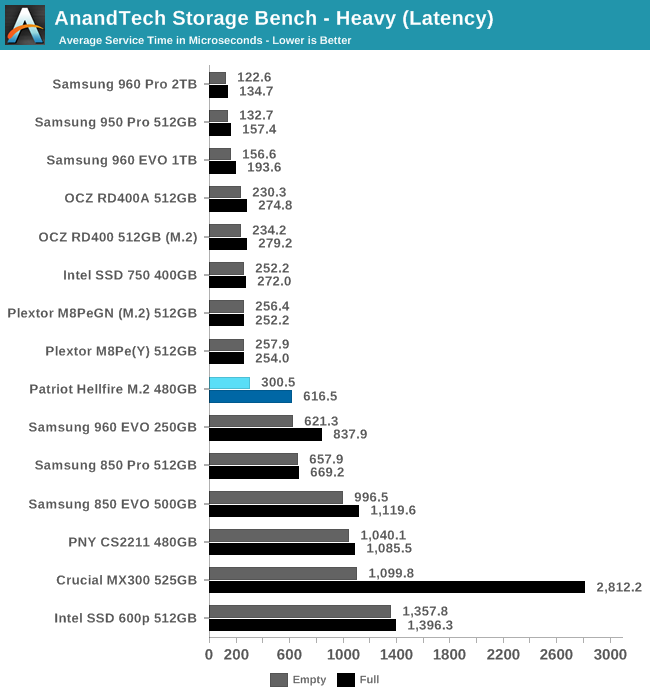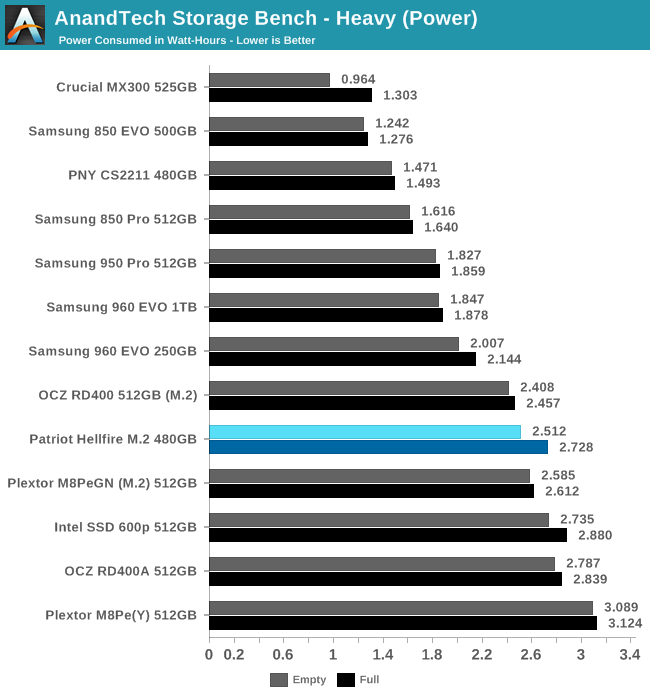The Patriot Hellfire M.2 480GB Review: Phison NVMe Tested
by Billy Tallis on February 10, 2017 8:30 AM ESTAnandTech Storage Bench - Heavy
Our Heavy storage benchmark is proportionally more write-heavy than The Destroyer, but much shorter overall. The total writes in the Heavy test aren't enough to fill the drive, so performance never drops down to steady state. This test is far more representative of a power user's day to day usage, and is heavily influenced by the drive's peak performance. The Heavy workload test details can be found here.

The Patriot Hellfire exhibits an unusually large disparity in performance when the Heavy test is run on a full drive compared to an empty drive. Fresh out of the box, the Hellfire largely keeps pace with the other MLC NVMe SSDs, but when full its average data rate drops down into the high end of SATA performance territory.

The average service times tell the same story as the average data rates: when the Patriot Hellfire is not filled, it can be lumped in with most of the other NVMe SSDs, but when it is completely full it loses almost all of its advantage over high-end SATA SSDs.

The Patriot Hellfire experiences relatively few high-latency outliers when the Heavy test is run on a fresh drive, but when filled is experiences substantially more outliers and it ranks worse than any MLC SSD in this comparison—NVMe or SATA.

The Patriot Hellfire is not the most power-hungry NVMe SSD in this bunch, but it is still substantially less efficient than Samsung's SSDs and mainstream SATA SSDs.










43 Comments
View All Comments
Magichands8 - Friday, February 10, 2017 - link
The problem is that there's nothing cheap about these. In fact, price per GB for SSDs seems to be going up even for the 'just good enough' crowd! And after all these years capacities are still a joke. To me, those are much bigger concerns than the name given to the drive. But we're going to have to put up with it for quite a while by simply not buying anything. Companies are going to keep doing this as there's apparently a large part of the buying public who are determined to throw pearls before swine on overpriced and low capacity SSDs. At least Patriot has done SOMETHING about the performance aspect.Murloc - Friday, February 10, 2017 - link
you're wrong, I can now buy something double the size and with better performance at the same price I bought my 840 evo.MR_Roberto - Monday, February 27, 2017 - link
ehh? tell me what product that is.. i want to buy it xDphexac - Friday, February 10, 2017 - link
Now, that is one crappy SSD.jjj - Friday, February 10, 2017 - link
You guys should use these traces to measure power consumption in CPU reviews.There is way too much focus on "max load". Guess AT does have some more relevant tests for laptop reviews but in CPU reviews, the power section is tragic.
Billy Tallis - Friday, February 10, 2017 - link
Unfortunately, these traces are just playing back the I/O, not actually re-running the whole application. The CPU load they present is trivial.jjj - Sunday, February 12, 2017 - link
Hmm so that can distort the SSD perf tests a bit for workloads that are CPU heavy.Maybe a dedicated article would be interesting. Even more so when you get Xpoint drives, next year i guess for proper capacities.
Guess the SSD power tests could factor in perf and CPU utilization for extra accuracy.
Billy Tallis - Monday, February 13, 2017 - link
The distortion should be minimal. Recording the traces in the first place incurred very little overhead. The trace doesn't perfectly capture the dependencies between operations, but the playback does preserve the ordering and queue depths and relative timing, except that long disk idle periods are cut short. I'll cover this in detail in when I launch the 2017 test suite.BurntMyBacon - Monday, February 13, 2017 - link
Your efforts are appreciated.jjj - Monday, February 13, 2017 - link
Just to be clear, i was thinking the CPU becoming a bottleneck in some situations and that there might be significant differences in CPU load per unit of perf between SSDs that could lead to significant differences in real usage.